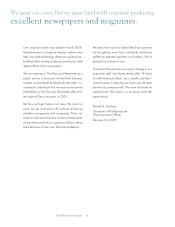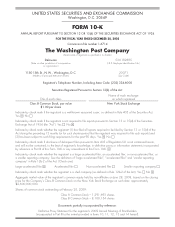Washington Post 2008 Annual Report Download - page 20
Download and view the complete annual report
Please find page 20 of the 2008 Washington Post annual report below. You can navigate through the pages in the report by either clicking on the pages listed below, or by using the keyword search tool below to find specific information within the annual report.whether a cable operator may offer public, educational and governmental (“PEG”) access channels as part of a “digital
basic” service that costs no more than analog basic service, but that may require some subscribers to obtain additional
equipment to receive the PEG channels.
Pole Attachments. Pursuant to the Pole Attachment Act, the FCC exercises authority to disapprove unreasonable rates
charged to cable operators by most telephone and power utilities for utilizing space on utility poles or in underground
conduits. The FCC has adopted two separate formulas under the Pole Attachment Act: one for attachments by cable
operators generally and a higher rate for attachments used to provide “telecommunications services.” However the Pole
Attachment Act does not apply to poles and conduits owned by municipalities or cooperatives. Also, states can reclaim
exclusive jurisdiction over the rates, terms and conditions of pole attachments by certifying to the FCC that they regulate
such matters, and several states in which the Company has cable operations have so certified. A number of cable
operators (including the Company’s Cable ONE subsidiary) are using their cable systems to provide not only television
programming, but also Internet access and digital voice. In 2002, the U.S. Supreme Court held, based on a prior FCC
ruling that Internet access service provided by cable operators is not a “telecommunications service,” that the lower pole
attachment rates apply not only to attachments used to provide traditional cable services, but also to attachments used to
provide Internet access. The FCC has not yet finally determined whether digital voice provided by cable operators is a
“telecommunications service” that would trigger the higher pole attachment rates. In November 2007, the FCC issued a
Notice of Proposed Rulemaking exploring whether to effectively eliminate cable’s lower pole attachment fees by imposing
a higher unified rate for entities providing broadband Internet service, which could moot the foregoing precedent. While
the outcome of this proceeding can not be predicted, changes to Cable ONE’s pole attachment rate structure could
significantly increase its annual pole attachment costs.
Federal Copyright Issues. The Copyright Act of 1976 gives cable television systems the ability, under certain terms and
conditions and assuming that any applicable retransmission consents have been obtained, to retransmit the signals of
television stations pursuant to a compulsory copyright license. Those terms and conditions require all cable systems that
retransmit broadcast signals to pay semi-annual royalty fees, generally based on the systems’ gross revenues from basic
service and, in certain instances, the number of “distant” broadcast signals carried. The compulsory license fees have
been increased on several occasions since this act went into effect. Since 1989, a separate compulsory copyright license
for distant signal retransmissions has applied to direct broadcast satellite (“DBS”), and in 1999, Congress provided DBS
with a royalty-free compulsory copyright license for distribution of the signals of local television stations to satellite
subscribers in the markets served by such stations. The cable compulsory license for local and distant signals and the DBS
local signal compulsory license are permanent, while the DBS distant signal compulsory license is scheduled to sunset at
the end of 2009. In addition, the cable and DBS compulsory licenses employ different methodologies for calculating
royalties, with cable using a percentage of revenues approach and DBS using a flat, per subscriber, per signal payment
approach.
In 2008, the Copyright Office terminated a proceeding in which it had been requested to adopt rules that would allow
cable operators to calculate their compulsory license fees on a community-by-community basis, rather than on a system-
wide basis, that could result in the payment of royalties for “phantom signals” that are only carried in a portion of the
system. The Copyright Office also is considering requests for clarification of the application of the cable compulsory
license to the retransmission of distant digital television broadcast signals and for clarification and revisions of certain
cable compulsory copyright license reporting requirements. Moreover, in June 2008, the Copyright Office recommended
to Congress that, as part of its consideration of whether to extend the expiring DBS compulsory license in 2009, it adopt
a “phase out” of both the cable and DBS distant signal compulsory licenses or, in the alternative, “harmonize” the two
licensing schemes by replacing the gross-revenues-based formula applicable to cable with the “flat fee” approach
applicable to DBS. We cannot predict the outcome of any such inquiries, rulemaking proceedings or legislative initiatives;
however, it is possible that changes in the rules or copyright compulsory license fee computations or compliance
procedures could have an adverse effect on our business by increasing our copyright compulsory license fee costs or by
causing us to reduce or discontinue carriage of certain broadcast signals that we currently carry on a discretionary basis.
Telephone Company Competition. The Telecommunications Act of 1996 permits telephone companies to offer video
programming services in areas where they provide local telephone service. Over the past decade, telephone companies
have pursued multiple strategies to enter the market for the delivery of multichannel video programming services. Initially,
some telephone companies partnered with DBS operators to resell a DBS service to their telephone customers. Some
telephone companies still do this, but other telephone companies have entered into traditional franchise agreements with
local franchising authorities and have constructed their own video programming delivery systems. Still other telephone
companies have developed other methods to deliver video programming that, depending on the technology employed,
may be regulated in a manner similar to the Company’s cable systems. Some telephone companies have taken the
8THE WASHINGTON POST COMPANY
























